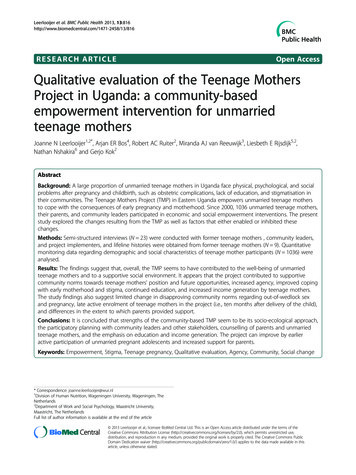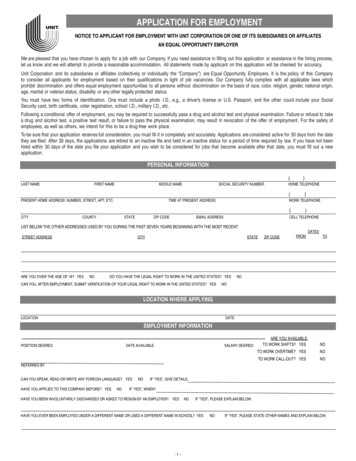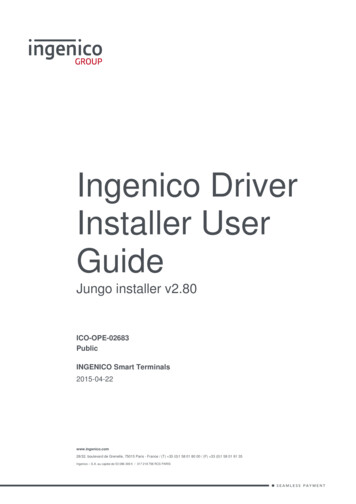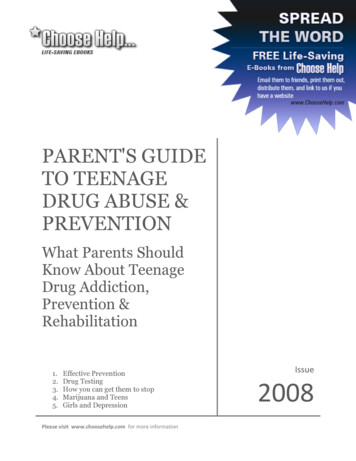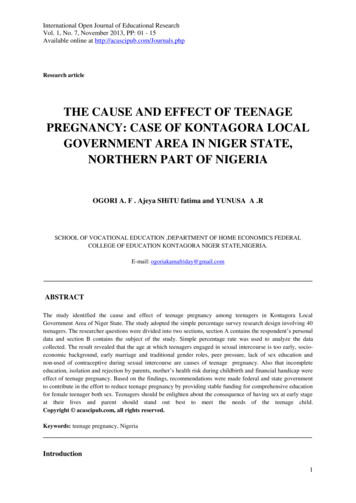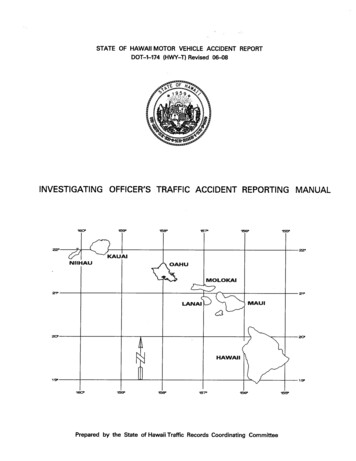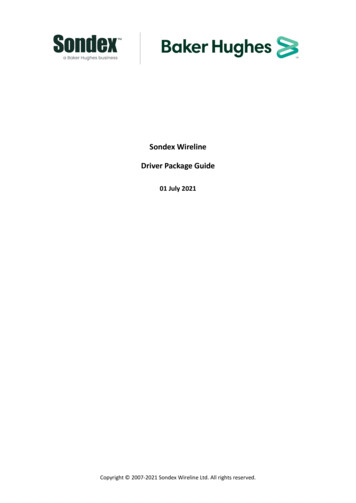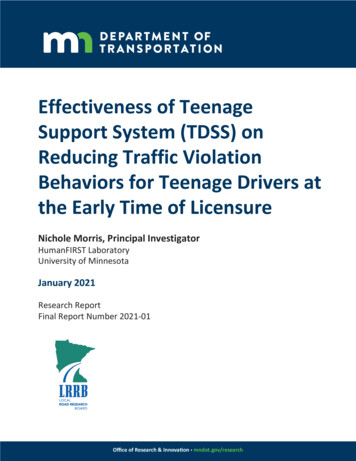
Transcription
Effectiveness of TeenageSupport System (TDSS) onReducing Traffic ViolationBehaviors for Teenage Drivers atthe Early Time of LicensureNichole Morris, Principal InvestigatorHumanFIRST LaboratoryUniversity of MinnesotaJanuary 2021Research ReportFinal Report Number 2021-01Office of Research & Innovation mndot.gov/research
To request this document in an alternative format, such as braille or large print, call 651-366-4718 or 1800-657-3774 (Greater Minnesota) or email your request to ADArequest.dot@state.mn.us. Pleaserequest at least one week in advance.
Technical Report Documentation Page1. Report No.2.3. Recipients Accession No.MN 2021-014. Title and Subtitle5. Report DateEffectiveness of Teenage Support System (TDSS) on ReducingTraffic Violation Behaviors for Teenage Drivers at the EarlyTime of LicensureJanuary 20217. Author(s)8. Performing Organization Report No.6.Tian, D., Morris, N. L., Donath, M.9. Performing Organization Name and Address10. Project/Task/Work Unit No.HumanFIRST LaboratoryDept. of Mechanical EngineeringUniversity of Minnesota111 Church St. SEMinneapolis, MN 55166CTS #201901512. Sponsoring Organization Name and Address13. Type of Report and Period CoveredLocal Road Research BoardMinnesota Department of TransportationOffice of Research & Innovation395 John Ireland Boulevard, MS 330St. Paul, Minnesota 55155-1899Final Report11. Contract (C) or Grant (G) No.(c) 1003325 (wo) 7614. Sponsoring Agency Code15. Supplementary Noteshttp:// mndot.gov/research/reports/2021/202101.pdf16. Abstract (Limit: 250 words)Teenage drivers are at a disproportionate risk of fatal and serious injuries due to motor vehicle crashes. A Field Operational Test (FOT)funded by MnDOT used the Teen Driver Support System (TDSS) smartphone application to collect real-time driving performance datafrom a cohort of approximately 300 teen drivers, recruited in early 2013, who were monitored over a 12-month period after licensure.Study results showed the TDSS application’s success in reducing instances of speeding for the two groups that received feedback,compared to teens who received no coaching or parental involvement, was influential in reducing kinematic driving events, e.g., hardbraking. This five-year follow-up investigation of the long-term outcomes of the TDSS FOT cohort aimed to determine the frequency ofstate-recorded traffic citations and crashes along with these drivers’ self-reported driving behaviors and attitudes. Of the original cohort,251 agreed to be contacted for future studies and 150 were successfully recruited into the follow-up study. A re-examination of the FOTrisky driving distributions divided into tertiles (low, moderate, high) found overdispersion of control group teens in the high risky tertilescompared to the two TDSS intervention groups, particularly for speeding-related behaviors and texting. The tertile risk level of earlyrisky driving (e.g., speeding, hard braking) was found to significantly predict long-term safety outcomes for traffic violations/tickets.However, the sample size for crashes among the over sample was too small to determine if the mediating effect of the TDSS on earlyrisky driving resulted in long-term reductions in crashes.17. Document Analysis/Descriptors18. Availability StatementTeenage drivers, Smartphones, Mobile applications, Intelligentspeed adaptation, Training, Traffic citations, Traffic crashes,Longitudinal studiesNo restrictions. Document available from:National Technical Information Services,Alexandria, Virginia 2231219. Security Class (this report)20. Security Class (this page)21. No. of PagesUnclassifiedUnclassified8922. Price
Effectiveness of Teenage Support System (TDSS) on ReducingTraffic Violation Behaviors for Teenage Drivers at the Early Time ofLicensureFINAL REPORTPrepared by:Disi Tian, M.S.Nichole L. Morris, Ph.D.Max Donath, Ph.D.HumanFIRST LaboratoryDepartment of Mechanical EngineeringUniversity of MinnesotaJanuary 2021Published by:Minnesota Department of TransportationOffice of Research & Innovation395 John Ireland Boulevard, MS 330St. Paul, Minnesota 55155-1899This report represents the results of research conducted by the authors and does not necessarily represent the views orpolicies of the Local Road Research Board, the Minnesota Department of Transportation, or the University of Minnesota. Thisreport does not contain a standard or specified technique.The authors, the Local Road Research Board, the Minnesota Department of Transportation, and the University of Minnesota donot endorse products or manufacturers. Trade or manufacturers’ names appear herein solely because they are consideredessential to this report.
ACKNOWLEDGMENTSThe authors would like to first thank the research teams responsible for the success of the original TeenDriver Support System Field Operational Test, particularly Janet Creaser, Chris Edwards, MichaelManser, Jennifer Cooper, Brandy Swanson, Craig Shankwitz, Alec Gorjestani, Arvind Menon, Eddie Arpin,and Annette Fritze. Thank you to current HumanFIRST staff Curtis Craig and Katelyn Schwieters for theirediting support for this work. Additionally, we would like to thank the original supporters and funders ofthis research at the Minnesota Department of Transportation, Sue Sheehan and Bernie Arsenau(formerly MnDOT). The current project could not have happened without the support of the MinnesotaLocal Road Research Board and the project Technical Advisory Panel members, including Joe Gustafson,Gordy Pehrson, Lisa Kons, Eric Devoe, Katie Fleming, Gayle Gedstad, Lisa Jansen, Mark Vizecky, JesseFarrell, and Dave Glyer. Finally, our deepest thanks to Andrew Ryan for his statistical support andguidance on this work.
TABLE OF CONTENTSCHAPTER 1: Introduction. 11.1 Project Objectives . 11.2 Teen Driver Crash Risk Overview . 11.3 Teen Driver Support System Overview . 31.4 Teen Driver Support System Follow up . 6CHAPTER 2: Focus Group and Survey Validation . 72.1 Part I: Focus Group Study . 72.1.1 Self-reported Citations and Crash Outcomes. 72.2 Summary . 10CHAPTER 3: TDSS Cohort Recruitment . 113.1 Recruiting Methods . 113.2 Recruiting Materials and Procedure . 133.3 Recruitment Outcomes . 14CHAPTER 4: Data Analysis . 154.1 The Effect of TDSS System on Traffic Violation Behaviors. 154.1.1 TDSS and Early Risky Driving Behaviors. 154.1.1 The Relationship between the TDSS System and Early Risky Driving Behaviors . 164.1.2 Early Risky Driving and Traffic Violation Behaviors . 204.1.3 Summary of Results . 23CHAPTER 5: CONCLUSIONS. 255.1 Study Overview . 255.2 Experiment Data Conclusions . 255.3 Benefits Evaluation . 265.3.1 Improved Safety . 26
5.3.2 Reduced Risk . 275.3.3 Quantification Approach . 275.4 Experiment Limitations and Future Directions . 29REFERENCES. 31APPENDIX A Updated Survey QuestionnaireAPPENDIX B Survey Data SummaryLIST OF FIGURESFigure 1.2 Screenshots of graded speed warnings for each stage of the advisory ISA feature in the TDSS. 5LIST OF TABLESTable 1.1 TDSS Cohort Sample for Final Analysis (adapted from Creaser et al., 2015) . 4Table 3.1 TDSS Cohort Participant Recruitment and Enrollment Overview . 14Table 4.1 Descriptions of early risky driving behaviors . 16Table 4.2 Baseline demographics of the young driver cohort at enrollment in 2014 . 17Table 4.3 Estimated risky driving event rates per 100 miles driven during the first year of licensure . 17Table 4.4 Estimated rate ratios (RR) for risky driving events per 100 miles driven during the first year oflicensure . 18Table 4.5 Distributions of the red speeding initiative tertiles across TDSS groups . 19Table 4.6 Distributions of the red speeding parent initiative tertiles across TDSS groups . 19Table 4.7 Distributions of the texting tertiles across TDSS groups . 19Table 4.8 Distributions of the hard acceleration tertiles across TDSS groups . 19Table 4.9 Distributions of the hard braking tertiles across TDSS groups . 20Table 4.10 Distributions of the hard turning tertiles across TDSS groups . 20Table 4.11 Frequencies of participants’ crash involvements recorded since full licensure . 20
Table 4.12 Distributions of the severity level of crashes . 21Table 4.13 Frequencies of participants’ citation/ticket involvement recorded since full licensure. 21Table 4.14 Distributions of citation/ticket type . 21Table 4.15 Multivariate analyses on the relationship between early risky driving and traffic violationsthrough Poisson regressions . 22Table 4.16 Multivariate analyses on the relationship between early risky driving and crashes throughPoisson regressions . 23Table 5.1 Cost of teen-involved motor vehicle crashes in 2018 . 27LIST OF ABBREVIATIONSApp: ApplicationDPS: Department of Public SafetyDVS: Driver and Vehicle ServicesFOT: Field Operational TestGDL: Graduated Driver’s LicenseGPS: Global Positioning SystemISA: Intelligent Speed AdaptationPDO: Property Damage OnlyRFID: Radio Frequency IdentificationTDSS: Teen Driver Support SystemTDSS Group: Experimental group with in-vehicle coaching onlyTDSS Group: Experimental group with in-vehicle coaching and parental feedback
EXECUTIVE SUMMARYTeenage drivers are at a disproportionate risk of fatal and serious injuries due to motor vehicle crashes.Because of inexperience and a risk-seeking propensity, novice teenage drivers are often more prone todemonstrate risky driving behaviors such as speeding and harsh maneuvers, especially during the firstfew months of licensure. A project funded by MnDOT used the Teen Driver Support System (TDSS)smartphone application to collect real-time driving performance data from a cohort of approximately300 teen drivers (age M 16), recruited between the months of February and June 2013, who weremonitored over a 12-month period after licensure. The TDSS collected data about risky driving behaviors(e.g., speeding, hard braking, sharp turning, and aggressive accelerating). Participants were placed inone of three groups: TDSS, TDSS , or a control group. The TDSS group received real-time coaching,primarily through a custom-designed intelligent speed adaptation system, the TDSS group receivednearly identical in-vehicle coaching but this group’s application notified parents of detected risky drivingbehaviors, via text message, email, and website logging, while the control group received no coaching.Results indicated that those who used the TDSS or TDSS had reduced instances of speeding comparedto teens in the control group. Further, parental involvement was influential in reducing kinematic drivingevents, e.g., hard braking. Preliminary analysis of the TDSS project also indicated that approximately10% of teens across all three experimental groups reported involvement in a crash, traffic citation,and/or ticket during the study period. However, it is unclear as to whether the TDSS affected thesetraffic violation and risky driving outcomes.A follow-up investigation of the TDSS Field Operational Test (FOT) cohort was conducted approximatelyfive years later to examine the frequency of state recorded traffic citations and crashes as well as severaldriver self-report measures (e.g., driving behaviors, attitudes, sensation seeking, and perceived risks).This follow-up study was conducted to understand the long-term effectiveness of an in-vehicle supportsystem, as well as to promote future implementations to a broader range of driver populations.An initial study was conducted with an aged-matched cohort focus group to develop and validate surveyinstruments related to driving safety. A packet of measures was assembled to assess driving history,behaviors, and attitudes toward driving safety. Interviews with the focus groups provided insight as towhen young drivers (20-22 years old) either engaged in risky driving or observed others engaging in riskydriving (i.e., as a passenger). Participants perceived their risky driving to be lower than as a teen driver inhigh school (e.g., less likely to drive drowsy, be influenced by passengers, or speed).Two-hundred and fifty-one of the original 300 teens in the TDSS FOT cohort agreed to be contactedregarding potential follow-up study opportunities (i.e., 83 in the control group, 86 in the TDSS group,and 82 in the TDSS group). Of the available 251 participants, 150 were located and successfullyrecruited into the follow-up study (i.e., 47 in the control group, 58 in the TDSS group, and 45 in theTDSS group). Study participants engaged in a series of surveys to provide information about theirdriving history, behaviors, attitudes, and self-reported crashes and citations. They also gave the researchteam authorization to formally request their crash and citation records from the Minnesota Departmentof Public Safety Driver and Vehicle Services. The Minnesota agency provided the research team detailedinformation about authorized participants’ citation records and provided limited information about their
crash history (i.e., frequency, date, and crash severity). Participants were paid 100 via Visa debit cardfor their participation.A new analysis of the 150 participants’ original driving performances and risky behaviors was conductedto re-establish the influence of experimental condition on driving performance during the 12-monthstudy. The analysis indicated that teen drivers in both the in-vehicle coaching conditions (i.e., TDSS andTDSS ) were significantly less likely to trigger a “red speeding warning” (i.e., exceeding 7 mph above thespeed limit) while driving, relevant to the control group. Similarly, the TDSS and TDSS groups were alsofound to have a significantly reduced rate of “red speeding parent notifications” (i.e., exceeding 7 mphabove the speed limit long enough to send a text notification to parents or log the event if not in theTDSS group), as well as significantly reduced rates of texting behaviors. However, while the TDSS system demonstrated a significant positive effect on reducing all three harsh driving maneuvers (i.e.,braking, turning, and accelerating), none of the results were statistically significant for the TDSS group(i.e., no parental feedback).Risky driving rates measured during the FOT were highly skewed to the right (i.e., over-dispersion to thesmall values), so these data were categorized into three levels (i.e., low, moderate, and high) to furtherquantify the risks by the tertile (i.e., distribution divided into thirds) cut-off points for each of thevariables. Differences in the distributions across the tertiles for the three experimental groups werefound to be particularly remarkable for the speeding-related behaviors and texting. Namely, the controlgroup was associated with the highest proportion of a “high” level of event rates, followed by the TDSSgroup and the TDSS group (e.g., 71.1% compared to 24.1% and 6.7%, respectively, for the red speedingparent initiatives). Similar trends were also observed for the harsh driving maneuvers. The results of theChi-square tests for each category of risky driving behavior also provided evidence of significantassociations between the TDSS treatment levels and the risky driving behavior levels.The state-recorded traffic violation/citation records for the participants indicated that 65 trafficcitations/tickets were documented from this cohort of young drivers. Approximately 70% of the youngdrivers were free of traffic citations/tickets. Excessive speeding-related citations/tickets were observedto be the most prevalent type of traffic citation/ticket, accounting for 89.5% (control), 70.1% (TDSS) and86.4% (TDSS ) of all recorded citations/tickets. The state-recorded traffic crash records for theparticipants indicated that 26 crashes occurred in the six years after they obtained their full driver’slicenses. Approximately 80% of the participants within all of the three groups were crash-free in thestate records. Of the documented crashes, there were four injury or possible injury crashes and 22property damage only crashes.The tertile risk groups for each of the risky behaviors were used in a series of multivariate analyses usingPoisson regressions to examine the relationship between early risky driving and long-term safetyoutcomes, i.e., traffic violations and crashes. The young drivers in the moderate and high tertile groupsfor all risky measurements, with the exception of red speeding parent initiative and texting, weresignificantly more likely to have a citation/ticket than those in the low risk-taking group. Only youngdrivers who had high red speeding parent initiative had a significantly higher likelihood of having aticket/citation compared to the low group. Finally, only young drivers who had moderate texting
behavior while driving had a significantly higher likelihood of a ticket/citation compared to the lowgroup. The multivariate analyses conducted to predict the likelihood of crash outcomes by early riskybehaviors appeared to be too small to determine if any significant differences existed. The analysesdemonstrated that there were no significant differences in the likelihood of crash by engagement inrisky behaviors in the first year of licensure.Risky driving behaviors in early licensure (e.g., excessive speeding and elevated g-force events) havebeen well recognized as strong precedent predictors for later crash involvement. In these currentinvestigations, the TDSS system demonstrated significant direct treatment effects on reducing the ratesof various risky driving outcomes over the first year of independent driving. Simultaneously, the rates oflater citation/ticket involvement were found to increase with an increase in the levels of all risky drivingbehaviors exhibited by young drivers, except for texting. However, due to small sample sizes, significantassociations between the risky driving behaviors and crashes were not observed in the currentassessment. The findings from the current study suggest that the use of real-time, in-vehicle coachingsystems may be effective for improving the safety of younger drivers, in both short- and long-termmetrics for risky driving engagement.
CHAPTER 1: INTRODUCTION1.1 PROJECT OBJECTIVESTeenage drivers are at a disproportionate risk of fatal and serious injuries due to motor vehicle crashes.Because of inexperience and a risk-seeking propensity, novice teenage drivers are often more prone todemonstrate risky driving behaviors such as speeding and harsh maneuvers, especially during the firstfew months of licensure. In an effort to reduce risky driving among novice teenage drivers, a cohort ofapproximately 300 drivers (M 16 years) was recruited and monitored over a 12-month period afterlicensure. This was done to collect their real-time driving performance data using the Teen DriverSupport System (TDSS) in a project funded by Minnesota Department of Transportation (MnDOT).Preliminary analysis of the TDSS project suggested that approximately 10% of these drivers reportedinvolvement in a crash, traffic citation, and/or ticket during the study period within each of the threeexperimental groups (i.e., control, interface-only, and interface plus parents). However, to what extentthe TDSS affected these traffic violations and risky driving outcomes over a longer term was yet to beknown. Therefore, this investigation will focus on 1) collecting information on these drivers’ selfreported driving behaviors, driving attitudes, sensation seeking, and perceived risks in a cross-sectionalapproach; and 2) collecting the traffic violation and crash outcomes from the Minnesota Department ofPublic Safety (DPS) since they were recruited into the TDSS project. The outcome of the study isexpected to clarify the long-term effectiveness of an in-vehicle support system as well as promote futureimplementations with a broader range of driver populations.1.2 TEEN DRIVER CRASH RISK OVERVIEWYoung drivers account for only a small proportion of the total driver population; however, they aregenerally overrepresented in crashes and traffic offenses, especially during the early period ofunsupervised driving. A survival analysis of self-reported crash involvement and citations revealed thatteenage drivers exhibit the greatest risk of incurring a first crash or citation during the first month or first500 miles driven within 12 months after licensure (McCartt, Shabanova, & Leaf, 2003).Previous literature on teenage driving has thoroughly documented several important factors that maybe attributable to increased crash and injury risks. In particular, male teenage drivers are at greater risksof fatal crashes and are more prone to engage in risky driving compared to females (Williams, 2003).Similarly, young male drivers are also found to exhibit more serious traffic violation behaviors andexperience crashes sooner than young female drivers (Waller et al., 2001; McCartt et al., 2003). Yagil’s(1998) identifying that young, male drivers considered traffic laws to be significantly less important thanother laws also supported this pronounced gender difference. However, some studies argued that thedriving risks among female teenage drivers should not be overlooked, in part because they may drivesubstantially fewer miles than male drivers (Jones, 2017).1
Furthermore, driving at an earlier age due to immature physical and psychological development(Steinberg, 2008) significantly increases the crash risk for teenagers, particularly in the nighttime and inthe presence of other teenage passengers (Williams, 2003; McCartt, Hellinga, & Haire, 2007).Specifically, peer passengers may also influence teenage drivers by encouraging distraction and a higherpropensity for thrill-seeking behaviors (Neyens & Boyle, 2008). Many studies have found that teens withsensation-seeking personalities and other personal traits, such as having more friends with risk seekingpersonalities, are more likely to be engaged in risky driving behaviors, and these drivers areoverrepresented in the frequency of excessive speeding over time (Simons-Morton et al, 2012; Hatfield,Fernandes, & Job, 2014). In a national survey, only 10%of teenage drivers perceived peer passengers asdangerous, yet over 60% reported witnessing this behavior quite frequently in the vehicles (Ginsburg etal., 2008). The potential negative influence of peer passengers appears to be significantlyunderestimated among adolescent drivers.Teenage drivers who have unsupervised access to vehicles or own vehicles have a greater chance ofbeing involved in risky driving events and traffic violations (Williams, 2003). Despite the combinedprevention efforts by the Graduated Driver’s License (GDL) laws and many parent provisions andeducation programs, teenager drivers are still found to have a greater proportion of deficient seatbeltuse and inattentive driving compared to other age groups. Several societal factors might have alsoaffected the occurrences of crashes and traffic offenses among young drivers. For instance, teenagedrivers were found to have an increased risk of being involved in a traffic offense or crash incident iftheir parents had repeatedly violated traffic laws or incurred crashes three and more times (Ferguson,Williams, Chapline, Reinfurt, & De Leonardis, 2001). Combinations of these risk factors have beenrecognized to cause a substantially higher crash risk and incidence of traffic offenses among teenagedrivers. Stricter parental control or involvement over teenage driving and improving the family safetyenvironment or culture have been incorporated as important elements of many driver educationinterventions and programs (Taubman-Ben-Ari & Katz-Ben-Ami, 2012).While traffic violation behaviors in general are correlated with crashes, their prevalence and trendappeared to be quite different among young drivers. Chapman, Masten, and Browning (2014) examinedcrash and traffic violation records for different ages of novice drivers during three phases includinglearner permit (12 months), provisional licensure (12 months with restrictions), and full licensure (24months). For novice drivers aged 16 and 17 years old, the total crash rate stayed relatively low in thelearner permit phase. It took the highest jump during the first few months of independent driving,declined rapidly for a period of months, and then continued a slow decline over the early years of fulllicensure. It was also found that over 70% of 16- and 17-year-old drivers were crash-free during the firstthree years of licensure (Chapman et al., 2014).While the traffic violation rate among novice teenage drivers also started low during the learner permitphase, the violation rate rapidly increased over the period of provisional licensure, and then peaked atthe time when drivers turned almost 18 years of age before slightly dropping off (Chapman et al., 2014).Moreover, regarding the severity of crashes and traffic violations, the likelihood of involvement in an“at-fault” crash or a serious type of traffic violation (e.g., DUI, speeding at greater than 15 mph, etc.)2
was found to decline as the year of licensure increased (Waller, Elliott, Shope, Raghunathan, & Little,2001) . As a result, these findings further justify the need for evaluations of traffic violation behaviors forthe TDSS cohort, since an increased risk of traffic violations was observed longer term followinglicensure and may persist until early adulthood.Drivers’ risk perceptions, driving attitudes and the prevalence of certain driving behaviors may undergosignificant changes from early teenage driving to early adulthood. Specifically, Buckley et al. (2017)conducted a survey among young drivers recruited from an emergency room department and revealedthat over 20% of them reported driving after drinking alcohol. Even worse, the frequency of riding with adriver who had been drinking was estimated to be up to 40% among both females and males. Similarly,young adult drivers, particularly males, were also found to be overrepresented in sleep-related crashesand other drowsy driving incidents (Filtness, Armstrong, Watson, & Smith, 2017). To
when young drivers (20-22 years old) either engaged in risky driving or observed others engaging in risky driving (i.e., as a passenger). Participants perceived their risky driving to be lower than as a teen driver in high school (e.g., less likely to drive drowsy, be influenced by passengers, or speed).

